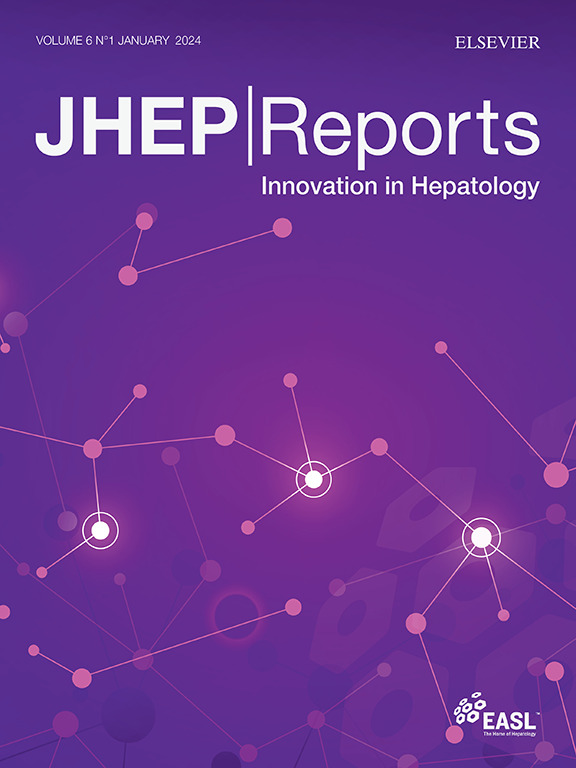Phosphatidylethanol and ethyl glucuronide to categorize alcohol consumption in alcohol-related cirrhosis
IF 7.5
1区 医学
Q1 GASTROENTEROLOGY & HEPATOLOGY
引用次数: 0
Abstract
Background & Aims
Phosphatidylethanol (PEth) is an alcohol-use biomarker that could bridge the detection windows of urinary ethyl glucuronide (uEtG) and scalp hair ethyl glucuronide (hEtG), but has been rarely validated in patients with liver disease. Reported detection windows of these biomarkers also vary significantly, and available studies have focused solely on any alcohol use. Yet, categorizing patients with liver disease based on their level of alcohol use would be highly informative. Here, we assessed the diagnostic accuracy and optimal detection windows of whole-blood PEth, uEtG, hEtG, and the novel biomarker fingernail ethyl glucuronide (nEtG), for different levels of alcohol use in patients with alcohol-related cirrhosis.
Methods
Patients with alcohol-related cirrhosis were questioned on their alcohol use over the previous 3 months using the Alcohol Timeline Followback (n = 116). In addition, 1–7-day (uEtG), 1–5-week (PEth), and 3-month (hEtG and nEtG) detection windows were assessed for any, increased (women ≥2 units/day or men ≥3 units/day), or excessive alcohol use (women ≥5 units/day or men ≥6 units/day).
Results
uEtG, PEth, and hEtG had high diagnostic accuracies for any alcohol use at optimal detection windows of 3 days [area under the receiver operating characteristic curve (AUROC): 0.990 (95% confidence interval (CI): 0.975–1.000)], 3 weeks [AUROC: 0.986 (95% CI: 0.958–1.000)], and 3 months [AUROC: 0.925 (95% CI: 0.862–0.987)], respectively. They had high negative predictive values (>92%) for increased and excessive use. nEtG showed promising results for assessing any alcohol use over the previous 3 months [AUROC: 0.962 (95% CI: 0.924–1.000)].
Conclusions
PEth and EtG have excellent and complementary diagnostic accuracies to detect any alcohol use and rule out increased alcohol use in patients with alcohol-related cirrhosis. nEtG provides an alternative for hEtG, but requires further validation.
Impact and implications
The correct identification and categorization of alcohol use is a major challenge in the treatment of patients with liver disease. Furthermore, given the new nomenclature toward steatotic liver disease, it has become essential to be able to categorize alcohol use into any, increased, or excessive use. The validation of PEth and urine, scalp hair, and nail EtG in patients with alcohol-related liver disease provides us with reliable options to overcome these issues in both clinical care and pharmacological trials on steatotic liver disease.
Clinical Trials registration
The study is registered at ClinicalTrials.gov (NCT04363424).

磷脂酰乙醇和葡萄糖醛酸乙酯对酒精相关性肝硬化患者饮酒的分类
背景,目的:磷脂酰乙醇(PEth)是一种酒精使用的生物标志物,可以连接尿乙基葡萄糖醛酸盐(uEtG)和头皮乙基葡萄糖醛酸盐(hEtG)的检测窗口,但很少在肝病患者中得到验证。报道的这些生物标志物的检测窗口也有很大差异,现有的研究只关注任何酒精使用。然而,根据他们的酒精使用水平对肝病患者进行分类将是非常有用的。在这里,我们评估了全血PEth、uEtG、hEtG和新型生物标志物指甲乙基葡萄糖醛酸酯(nEtG)对酒精相关性肝硬化患者不同酒精使用水平的诊断准确性和最佳检测窗口。方法采用酒精时间线随访(n = 116)对酒精相关性肝硬化患者在过去3个月内的酒精使用情况进行调查。此外,评估1 - 7天(uEtG)、1 - 5周(PEth)和3个月(hEtG和nEtG)检测窗口是否增加(女性≥2单位/天或男性≥3单位/天)或过度饮酒(女性≥5单位/天或男性≥6单位/天)。结果etg、PEth和hEtG在最佳检测窗口3天[受试者工作特征曲线下面积(AUROC): 0.990(95%可信区间(CI): 0.975 ~ 1.000)]、3周[AUROC: 0.986 (95% CI: 0.958 ~ 1.000)]和3个月[AUROC: 0.925 (95% CI: 0.862 ~ 0.987)]对任何酒精使用均具有较高的诊断准确性。他们对增加和过度使用有很高的负预测值(>92%)。nEtG在评估过去3个月的任何酒精使用情况方面显示出令人鼓舞的结果[AUROC: 0.962 (95% CI: 0.924-1.000)]。结论speth和EtG在检测酒精相关性肝硬化患者的任何酒精使用和排除酒精使用增加方面具有出色的互补诊断准确性。nEtG提供了hEtG的替代方案,但需要进一步验证。影响和意义正确识别和分类酒精使用是肝病患者治疗中的一个主要挑战。此外,鉴于脂肪变性肝病的新术语,有必要将酒精使用分为任意、增加或过度使用。酒精相关性肝病患者的PEth和尿液、头皮头发和指甲EtG的验证为我们在脂肪变性肝病的临床护理和药理学试验中克服这些问题提供了可靠的选择。临床试验注册本研究已在ClinicalTrials.gov注册(NCT04363424)。
本文章由计算机程序翻译,如有差异,请以英文原文为准。
求助全文
约1分钟内获得全文
求助全文
来源期刊

JHEP Reports
GASTROENTEROLOGY & HEPATOLOGY-
CiteScore
12.40
自引率
2.40%
发文量
161
审稿时长
36 days
期刊介绍:
JHEP Reports is an open access journal that is affiliated with the European Association for the Study of the Liver (EASL). It serves as a companion journal to the highly respected Journal of Hepatology.
The primary objective of JHEP Reports is to publish original papers and reviews that contribute to the advancement of knowledge in the field of liver diseases. The journal covers a wide range of topics, including basic, translational, and clinical research. It also focuses on global issues in hepatology, with particular emphasis on areas such as clinical trials, novel diagnostics, precision medicine and therapeutics, cancer research, cellular and molecular studies, artificial intelligence, microbiome research, epidemiology, and cutting-edge technologies.
In summary, JHEP Reports is dedicated to promoting scientific discoveries and innovations in liver diseases through the publication of high-quality research papers and reviews covering various aspects of hepatology.
 求助内容:
求助内容: 应助结果提醒方式:
应助结果提醒方式:


